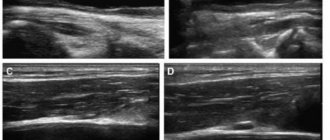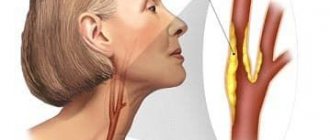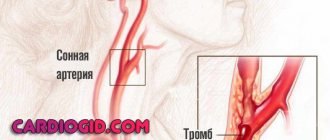Hyperkalemia is an upward deviation of potassium levels in the human body.
It can be caused by both malfunctions of the kidneys and abnormal release of potassium from the cells. Also common causes are acid-base imbalance and progressive uncontrolled diabetes.
Excess potassium can occur due to dehydration and consumption of foods rich in potassium, medications containing potassium, and the inability of the kidneys to remove potassium concentrates in the urine.
Hyperkalemia usually manifests itself as muscle weakness. To accurately diagnose high potassium levels, ECG (electrocardiography) is used, because an increase in the amount of potassium in the blood affects the performance of the myocardium.
Typical ECG changes in patients with hyperkalemia
General information
Hypokalemia means a decrease in serum potassium content to below 3.5 mmol/l, the deficiency of which can be caused by both a decrease in its reserves in the body and pathological movement into cells.
Most of the potassium (120–160 mmol/L) is normally found in the intracellular space (about 90%), and the remainder is found in the blood/bone tissue. The normal level of potassium in the body is its serum concentration from 3.5 to 5.5 mmol/l. The concentration of potassium in the blood is relatively constant, which is regulated by the processes of its entry into cells/excretion by the kidneys. The process of moving potassium from the blood through cell membranes is determined by the concentration of potassium outside the cell, the state of the membranes and cellular metabolism. The binding of potassium inside the cell occurs during the formation of protein and glycogen: it has been established that for 1 g of glycogen, 1 g of protein nitrogen and 0.3 mmol of potassium ions enter the cells. Potassium enters the body with food in an average amount of 2-3 g/day and is absorbed in the gastrointestinal tract (small intestine); excreted in urine (2-5 g), to a lesser extent in feces (less than 10 mmol). The volume/rate of potassium excretion is determined by many factors: potassium concentration in the blood, osmolarity, acid-base balance, the influence of vasopressin / aldosterone , and the rate of cell turnover.
The daily potassium requirement of an adult varies between 40–100 mmol/l. Vitamin B6 increases the efficiency of potassium absorption , while alcohol negatively affects its balance in the body. It should be taken into account that potassium from food is poorly absorbed in case of magnesium deficiency. Therefore, the lack of potassium and magnesium in the body is often interrelated. Normally, potassium balance is constantly maintained by the process of its excretion and intake with food. At the same time, the potassium content in the body is inversely proportional to the sodium content, that is, the more potassium, the less sodium, and vice versa.
Potassium takes an active part in the transmission of nerve impulses, the formation of cellular potentials, the contraction of smooth/skeletal muscle fibers, and cardiomyocytes. The macroelement increases stress resistance/physical endurance, coordinates heart rate, is responsible for normalizing blood pressure, and helps eliminate allergens/toxins from the body. Lack of potassium in the body in women and lack of potassium in men is a dangerous condition, since its functions in the body are extremely wide: potassium maintains the bioelectrical activity of cells, acid-base balance/water-salt balance; Helps stabilize heart rate, blood pressure, and maintain pH levels.
There are no reliable statistics on the prevalence of hypokalemia in the general population. It is important to understand that both manifest and especially subclinical hypokalemia are very common in clinical practice, but often remain unrecognized. However, potassium deficiency is detected in 3-20% of patients in gastroenterology/cardiology departments. The reason for the difficulty in recognizing hypokalemia is the variability/dynamism and variety of its clinical manifestations, and therefore hypokalemia imitates various organ/systemic pathologies.
How does hyperkalemia work in the kidneys?
In order to understand what processes occur in the kidneys during hyperkalemia, it should be understood that kidney performance depends on the following factors:
- A quantitative indicator of functional nephrons, which are the smallest elements of the kidney structure and consist of renal tubes and tubules,
- Normal levels of aldosterone, which is a hormone secreted by the adrenal glands,
- It is also important to have a normal fluid intake and a satisfactory amount of sodium in the blood.
The above components control the rate of GF (glomerular filtration rate). An excess of potassium is recorded when the GFR drops below 15 milliliters per minute, or a person’s urine output drops to less than one liter in 24 hours.
Normal glomerular filtration rates are 80-120 milliliters per minute.
A falling GFR is usually a sign of kidney failure, which in turn leads to hyperkalemia. Potassium can also be retained by the hormone renin. This happens because this hormone activates the work of aldosterone, and when it declines in the body, it leads to Addison’s disease.
This can be caused by certain medications (Captopril, Indomethacin). People suffering from diabetes and the elderly are mainly affected.
Renin is also affected by chronic nephritis, sickle cell anemia, direct kidney damage, and diabetes.
Impaired GFR accompanies renal failure, in which tissue death occurs and leads to rapid progression of hyperkalemia.
Pathogenesis
The pathogenesis of hypokalemia is diverse and determined by its form. The kidneys play a major role in maintaining potassium homeostasis. The level of potassium is determined by a combination of several processes, namely: potassium filtration, secretion and reabsorption. Since potassium in the blood plasma is in a free state, it is completely filtered in the renal glomeruli; potassium ions passing through the filter are almost completely reabsorbed in the distal/proximal tubules.
The process of potassium excretion by the kidneys is under humoral control, the main role in which belongs to mineralocorticoids ( aldosterone ), which both increases the penetration of potassium ions into the cells of the distal tubule and increases the permeability of the cell membrane to potassium, promoting potassium secretion. insulin also takes part in the processes of regulation of potassium excretion by the kidneys , which reduces the excretion of potassium by the kidneys. The state of acid-base balance has a significant influence on kaliuria. Thus, with alkalosis, hypokalemia develops as a result of the transition of potassium found in the blood plasma into cells. Potassium deficiency is observed with increased/accelerated breakdown of proteins in the body, which helps to force the release of potassium.
Interpretation of results
An increase in potassium can occur in a variety of conditions, including: kidney disease, decompensated diabetes mellitus, hypoaldosteronism and dehydration.
Among the most common causes of high potassium levels in the blood, medications such as ACE inhibitors, diuretics and sartans should also be highlighted. Hyperkalemia puts you at risk for serious problems with your heart rhythm or heart conduction.
| High potassium in the blood: possible causes | |
| Increased consumption |
|
| Decreased potassium excretion in urine |
|
| Potassium release from cells |
|
In any case, the test results should be assessed as a whole by a general practitioner who knows the patient's medical history. Therapeutic treatment of hyperkalemia depends on its severity and mechanism.
Treatment may include:
- reducing potassium intake;
- suspension of therapy causing hyperkalemia;
- use of drugs to increase potassium excretion.
Causes
The causes of hypokalemia are quite varied, the main ones of which include:
- Insufficient intake of potassium from food (poor nutrition/strict diets), monotonous diet.
- Excessive consumption of sugar, coffee-containing drinks, alcohol.
- Excessive intake of sodium, cesium, thallium and rubidium into the body.
- Potassium loss due to various diseases of the gastrointestinal tract ( ulcerative colitis / pancreatitis ), various intestinal infections that manifest themselves with repeated diarrhea / vomiting .
- Primary/secondary hyperaldosteronism . Under the influence of aldosterone, the process of excretion of potassium ions by the kidneys is stimulated.
- Endocrine diseases ( thyrotoxicosis Itsenko-Cushing disease/syndrome , genetically determined dysfunction of the adrenal cortex).
- Kidney diseases ( interstitial nephritis / renal tubular acidosis ), occurring with tubular dysfunction, which leads to increased potassium excretion.
- Redistribution (changes in the ratio) of potassium between the interstitium and the cell - the transition from the extracellular space of K+ into the cells. Occurs with alkalosis (pH shift to the alkaline side).
- Neuropsychic overload, excessive stress factors.
- Use of high doses of glucocorticoids.
- Taking certain medications. The table below shows the main drugs that induce hypokalemia and the mechanisms of its development.
- Other causes are large area burns hypomagnesemia , Barter-Gittelman syndrome .
Where does excess potassium come from?
The causes of hyperkalemia are most often associated with improper electrolyte distribution (leave from cells into the extracellular space) or its accumulation.
Loss of potassium by cellular elements of the blood (leukocytes, erythrocytes and platelets) is observed with high leukocytosis, destruction of erythrocytes and platelets. Such hyperkalemia is called “false” because in other tissues the intracellular concentration does not change.
The mechanism of electrolyte redistribution from the cell to the extracellular space is typical for:
- states of acidosis (shift in blood pH towards acidification);
- insulin deficiency;
- overdose of drugs with beta-blocking effects;
- traumatic shock;
- consequences of chemotherapy for tumors, multiple myeloma, treatment of leukemia;
- severe alcohol intoxication;
- heavy physical activity;
- negative effects of drugs (cardiac glycosides, muscle relaxants with depolarizing properties).
The most common cause of hyperkalemia is renal pathology, diseases that impair the excretion of potassium in the urine and contribute to the accumulation of its content in the blood.
Symptoms
Symptoms of hypokalemia depend on the level of potassium in the body, however, it should be borne in mind that plasma potassium concentrations do not accurately reflect the state of potassium balance. Symptoms and complaints of patients accompanying a decrease in potassium concentration in the body are nonspecific and quite varied, so in most cases we are not talking about the clinical picture, but about various clinical masks of hypokalemia.
The main signs of potassium deficiency are observed when its total amount decreases in the range of 10-30%; a decrease in potassium content below 1.5 mmol/l causes paralysis of the respiratory muscles. Symptoms of potassium deficiency in the body in women and potassium deficiency in the body in men manifest themselves with the same symptoms.
The first signs of potassium deficiency are associated with impaired neuromuscular excitability, which is caused by impaired polarization/depolarization of cell membranes and is manifested by asthenia / muscle weakness , increased fatigue , paresthesia /muscle spasms, and decreased tendon reflexes. With chronic hypokalemia, functional disorders and structural damage to both the peripheral and central nervous systems appear, which is realized by psycho-emotional disorders in the form of hypochondriacal, asthenic or anxiety-depressive syndromes.
Sensory disturbances manifest as mild paresthesia of the limbs/face or loss of tactile/pain sensitivity or severe hyperesthesia . Movement disorders correlate with the severity/duration of hypokalemia, ranging from mild muscle weakness of the upper and lower extremities, decreased tendon reflexes, to paralysis, including respiratory muscles. Hypokalemia can also manifest itself in symptoms/changes in the digestive system (intestinal paresis, flatulence , vomiting, paralytic intestinal obstruction constipation ), as well as in the genitourinary system ( polyuria , atony of the bladder , necrosis in the kidneys).
One of the most common manifestations of hypokalemia are disorders of cardiovascular activity, which are characterized by dilation of the cavities of the heart, decreased contractile function of the myocardium, the presence of systolic murmur at the apex of the heart, and decreased blood pressure .
The damaging effect of potassium ion deficiency in the body is well reflected in the ECG, which allows it to be used as a kind of indicator of latent hypokalemia. Characteristic ECG signs of hypokalemia include ventricular extrasystoles , T wave depression/inversion, QRS prolongation, pronounced U wave, and ST segment depression (Figure below).
As a rule, with potassium deficiency, there is a decrease in mental/mental activity, manifested in lethargy, apathy, and with a significant deficiency, the development of a coma is possible.
How is hyperkalemia treated?
Therapy, in the treatment of this pathology, is aimed at restoring normal potassium levels in the blood, eliminating complications and symptoms caused by hyperkalemia. Treatment differs for different degrees of hyperkalemia severity.
Mild degrees of severity include a concentration of no more than 6 mmol/l, with normal ECG readings.
In this case, therapy is limited to:
- Introducing a low potassium diet
- Eliminate the influence of medications that change the level of potassium in the blood,
- Introduce a loop diuretic (at the doctor’s choice) to enhance the removal of potassium from the body.
Polystyrene, which is dissolved in sorbitol, is preferably recommended. This drug binds excess potassium and removes it through the intestinal mucus. A side effect is an increase in sodium concentration in the blood as potassium is converted to sodium.
You can include the following foods in your diet that reduce potassium levels in the blood:
- Fresh vegetables. Among vegetables, carrots and cabbage are perfect for eliminating hyperkalemia,
- Products from the greens category. It would be appropriate to eat onions, asparagus, celery and parsley,
- Among the berries that lower potassium include: cranberries, blackberries, blueberries and strawberries,
- Fresh fruits such as plums, peaches, pineapples, grapes have a positive effect on potassium,
- Citrus fruits: lemons, tangerines, oranges.
- Pasta,
- Rice,
- alfalfa sprouts,
In addition to introducing foods that lower potassium, you should exclude from the diet those foods that promote its growth.
Among them:
- Watermelons,
- Any types of chocolate,
- Nuts, pistachios, seeds of any kind, raisins,
- Wheat,
- Salmon and tuna
- Milk products,
- Tomatoes (tomato paste), beets,
- Soy products,
- Dates.
In the case of mild hyperkalemia in infants, proper nutrition is necessary for both the mother who is breastfeeding and the child.
Preparing quick meals such as mivina, porridge and soups in bags, etc. is not recommended.
Therapy for moderate and severe degrees implies more potent and urgent measures to normalize the level of potassium in the blood.
When the accumulation of potassium in the blood is more than 6 mmol/l, and accompanied by deviations in the cardiogram (ECG), urgent therapy is needed aimed at moving potassium away from the body.
First of all, you need to do the following:
- Introduce calcium gluconate (10%) in a volume of ten to twenty milliliters . This will prevent the effect of increased potassium on the myocardium. Calcium gluconate should be administered only as prescribed by a doctor, and strictly under his supervision. Since if you introduce calcium gluconate, while consuming glycosides (Digoxin), arrhythmia caused by a lack of potassium in the body may begin to progress. In case of deviations on the cardiogram, in the form of a wave, or cessation of heart activity, the supply of the drug can be increased to 10 milliliters in two minutes. Relief will come after a couple of minutes, but will not last long. After 30 minutes everything will resume, so the effect is only temporary,
- The use of insulin in the amount of 5-10 units per vein , immediately followed by the introduction of a glucose solution with a concentration of 50%, in the amount of 50 milliliters, as well as dextrose, will help lower potassium levels after an hour, and will last as long as possible. The duration of action reaches several hours. The peak effect is observed one and a half hours after administration,
- The use of inhalations with the drug Albuterol lowers blood potassium saturation levels for up to an hour and a half. You need to breathe 10 milliliters of solution,
- In order to quickly remove excess potassium from the body during hyperkalemia, polystyrene sulfonate is used . All of the above measures are not able to treat kidney failure; it should be carried out when connected to an artificial kidney machine (hemodialysis).
- A controversial option is the injection of NaHCO (sodium bicarbonate ). Introducing it into the body briefly reduces potassium levels in the body. If there are kidney pathologies, the effectiveness of treatment in this way decreases.
Hyperkalemia, which is clearly progressive and reflected in the cardiogram, puts the patient’s life at risk. With such deviations, it is necessary to urgently apply treatment to normalize potassium in the blood.
In case of kidney failure, patients are connected to a hemodialysis machine to remove large amounts of potassium in the blood.
Hemodialysis machine
Effective treatment can only be prescribed by a qualified doctor, since individual indicators and concomitant diseases are different for everyone.
But in most cases, an intensive course of treatment is the use of all of the above methods.
To prevent relapses, you must carefully monitor your diet and medication intake. For all questions, it is better to consult a qualified doctor.
Tests and diagnostics
The diagnosis is based on laboratory and instrumental methods of examining the patient:
- Laboratory research. The blood CBS and concentrations of potassium, magnesium, and sodium are determined. A biochemical blood test determines the concentration of urea and creatinine; in urine analysis - the presence of chlorine/relative density.
- Hormone tests. The level of aldosterone/renin is determined, and the renin-aldosterone ratio is calculated. According to indications, tests are carried out for 17-OH-progesterone, cortisol , thyroid-stimulating hormone .
- Electrocardiography. The ECG looks for characteristic ECG signs of hypokalemia (QT interval prolongation, ST segment depression, presence of a U wave).
- Instrumental research. Ultrasound/CT of the adrenal glands, ultrasound of the kidneys with Dopplerography. According to indications - echocardiography.
- In addition to determining the potassium content, diagnosing the causes of hypokalemia is also important, the algorithm of which is shown in the figure below.
How does the analysis take place?
A potassium test is a laboratory test that is performed after a simple blood test.
There are no special preparation rules before undergoing the analysis. It is recommended not to eat before the test, although this is not necessary. However, you must tell your doctor what medications you are taking, as many medications can affect the test result.
Also, the method used for collection and testing may affect potassium levels. Factors that can cause high potassium values if not performed correctly include:
- tourniquet applied too tightly;
- patients forcefully open and close their fist while collecting blood;
- samples are analyzed late;
- The blood is collected into the tube too quickly.
In this case, the physician should consider very carefully whether and how to repeat the potassium test.
Diet
There is no special diet, but adjusting the diet to include foods rich in potassium is a critical component of correcting hypokalemia. For this purpose, it is recommended to include in the diet dairy products (milk, cottage cheese and sour cream), legumes, oatmeal/buckwheat, mushrooms, potatoes, bread with bran, tomato, sea fish (mackerel, pollock, salmon, tuna, sprat), cabbage (cauliflower/white cabbage/broccoli), carrots, cucumbers, greens (parsley, spinach), seaweed, fresh fruits (peaches, bananas, kiwi, avocados, apricots), nuts, dried fruits (prunes, dried apricots, raisins), compotes, black tea, cocoa, tomato juice, freshly squeezed juices (grape, orange, carrot), chocolate.
Unnatural sugar-containing drinks (lemonade, Coca-Cola, Fanta, Pepsi) should be limited/completely excluded from the diet. The consumption of salt is also subject to restrictions, but at the same time, a salt-free diet is not allowed. It is important to consider that most of the potassium dissolves in water during heat treatment, so you need to boil foods in a minimum amount of water.
How to prevent hyperkalemia?
In order to prevent the occurrence of this pathology, it is necessary to adhere to a certain diet, with approximately equal saturation of nutrients.
Diet adjustments to prevent high potassium levels are as follows:
- The daily intake of potassium should be from 2000 to 3000 milligrams per day,
- Reduce as much as possible or completely remove red meat from your diet. For prevention, it is better to use non-fatty meat (chicken, turkey), or fish,
- Eliminate fast food from your diet,
- Eat more beans, they saturate the body with protein,
- Exclusion of fermented milk products (milk, kefir, cheese, and ice cream),
- Do not eat foods high in potassium. These include bananas, peaches, potatoes, watermelon, salmon,
- Remove corn, soy, and foods with preservatives and chemical additives from your diet.
- Reduce your consumption of confectionery, French fries and margarine,
- Maintain the required water balance by drinking 1.5 to 2 liters of clean water per day,
- Do not drink alcohol, cigarettes,
- Avoid too strong tea and caffeinated products.
- Set aside at least thirty minutes a day for warm-up and physical activity.
Herbal teas will also help maintain the normal state of the body. They can be infused and used as tea.
These herbs include:
- nettle,
- Medicinal dandelion,
- Horsetail Leaves,
- Alfalfa.
Prevention
Preventive measures boil down to:
- A balanced diet with a sufficient amount of potassium-containing products without violating the rules of heat treatment.
- Eliminating low-calorie diets and giving up bad habits.
- Sleep/wake optimization.
- Limiting mental and nervous overload.
- Replacing (if possible) diuretics and other medications that help remove potassium from the body. If it is impossible to replace them, it is necessary to regularly undergo laboratory testing to determine the concentration of potassium in the serum.
- Limiting table salt consumption.
- Periodic use for the preventive correction of hypokalemia Panangin (1 tablet 3 times a day) for 3 weeks.
How to control normal blood potassium levels
- In cases of hyperkalemia, your doctor may prescribe ion exchange resins , which act in the intestines to bind potassium found in food. This helps eliminate the element in feces and reduces its absorption into the blood.
- Practicing regular exercise can help eliminate potassium from sweating. There is no need to do grueling workouts, just a walk or bike ride is enough.
- Eating right helps limit the amount of potassium you consume. In fact, potassium is found in most foods and drinks, including fruits and vegetables. In case of high blood potassium levels, ketchup, sauces, chocolate, cookies, fruits, potatoes, wine, beer and coffee may be limited; One portion of fresh fruit can be consumed per day, while the second portion should be consumed in cooked form.
In case of hyperkalemia, it is recommended to sharply reduce the consumption of fruits very rich in potassium (such as bananas) and dried nuts (such as walnuts, almonds, raisins and pine nuts).
Consequences and complications
The most significant complication of hypokalemia is cardiac arrhythmia ( ventricular fibrillation / ventricular tachycardia ), which can be fatal in the absence of timely qualified medical care. In some cases, respiratory failure may develop due to weakness of the intercostal muscles/diaphragm. Hypokalemia increases sensitivity to cardiac glycosides, which is accompanied by the risk of glycoside intoxication. Rarer complications are intestinal obstruction and the development of chronic renal failure .
Causes of high potassium in the blood
High levels of potassium in the blood can be seen with the following health problems:
- decreased renal function (nephropathy, acute and chronic renal failure, renal tubular acidosis, etc.);
- increased consumption of foods high in potassium, fasting, and relative insulin deficiency;
- obstruction (obstruction) of the urinary tract;
- decompensated diabetes mellitus;
- diabetic ketoacidosis;
- Addison's disease;
- hypoaldosteronism;
- systemic lupus erythematosus;
- sickle cell anemia;
- digoxin (digitalis) poisoning;
- infections;
- dehydration;
- intense physical activity;
- red blood cell disorders, thrombocytosis and leukocytosis.
Potassium in the blood above normal may be the result of increased tissue catabolism, as occurs in the case of:
- bleeding of soft tissues or gastrointestinal tract;
- acute intravascular hemolysis;
- massive cell death and tissue necrosis;
- tumor lysis syndrome.
Excess potassium often occurs in the presence of:
- cellular mechanical damage;
- muscle breakdown (rhabdomyolysis);
- severe burns;
- adrenal insufficiency;
- severe injuries.
Increased potassium may also occur due to iatrogenic causes, such as massive blood transfusions, chemotherapy, and the use of supplements or medications containing potassium salts (eg, penicillin G or potassium phosphate).
Other medications that often cause high blood potassium levels include:
- diuretics (such as triamterene and spironolactone);
- non-steroidal anti-inflammatory drugs (for example, ibuprofen and diclofenac);
- angiotensin receptor blockers (for example, losartan);
- cyclosporine and tacrolimus (medicines used to prevent transplant rejection);
- β-blockers (such as atenolol);
- ACE inhibitors (ramipril, captopril, etc.)
- sartans (which counteract the effects of aldosterone on potassium excretion).
List of sources
- Nascimento L. Hyperkalemia and hypokalemia // Difficult diagnosis: In 2 volumes / Ed. R.B. Taylor, vol. 1. M., Medicine, 1992, p. 302-322.
- Manual of clinical laboratory diagnostics. Part 3: Clinical biochemistry/Ed. prof. M.A. Bazarnova, prof. V.T. Morozova. K., Vishcha school, 1986, p. 216-223.
- Sokovets T.G., Bogdanov E.I. Hypokalemic myoplegia//Kazan Medical Journal. 2013. pp.933–938.
- Molashenko N.V., Platonova N.M., Yukina M.Yu. and others. Primary aldosteronism. Collection of methodological recommendations. Ed. E.A. Troshina. Tver: Triad; 2021.
- Heitz U. Water-electrolyte and acid-base balance. Per. from English M.: Binom; 2009.
How to cook low potassium foods
Prepare food with some caution as this may affect the excess amount of potassium consumed in the diet.
Before use, it is advisable to cut potatoes and raw vegetables (dill, onions, carrots, etc.) into small pieces and immerse them in a large amount of warm water for about two hours, then change the water and repeat the procedure at least one more time. Thus, a large amount of potassium is removed (like salt, this element is also soluble in water). Then drain the liquid and cook, removing the peel if possible.
Hypokalemia: treatment
The main goal of therapy is to stop the body losing potassium. To do this, it is necessary to eliminate the cause of hypokalemia. At the same time, the deficiency is corrected.
Treatment of hypokalemia with potassium supplements is mandatory. For mild pathological processes, medications are usually prescribed in tablet form, for example, Asparkam or Panangin. In severe cases, intravenous solutions containing potassium chloride or potassium bicarbonate are required. However, intravenous infusions are contraindicated in patients whose problem is caused by impaired potassium redistribution (with the exception of familial hypokalemic periodic paralysis), since the risk of developing rebound hyperkalemia is high.
In some cases, the use of antiarrhythmic drugs - propafenone or amiodarone - is required to eliminate arrhythmia. In case of ventricular fibrillation, defibrillation is necessary.








